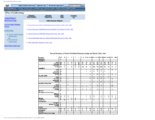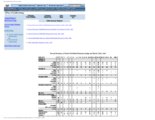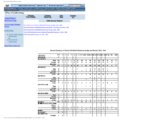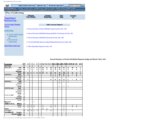A repository for documents, reports, and publications from the Utah Department of Health.
TO
Filters: Collection: "ehsl_ophl" Subject: "Utah"
| Title | Creator | Description | ||
|---|---|---|---|---|
| 1 |
 |
1996 Health Status Survey : Health Care Access and Utilization / | Utah. Office of Public Health Data; Utah. Bureau of Surveillance and Analysis | Assuring access to health care has been defined by the Institute of Medicine as one of the key functions of government in public health1. In addition to the ability to access medical care for an acute medical problem, having a primary health care provider, or a "medical home" is also believed to pro... |
| 2 |
 |
1996 Health Status Survey : Interpersonal Violence in Utah / | Utah. Office of Public Heallth Data; Utah. Bureau of Surveillance and Analysis | Interpersonal violence is increasingly recognized as an important issue in public health. Violent acts, such as child abuse, domestic violence, elder abuse, and gang violence cause physical and emotional harm to persons, and harm families and communities. The prevalence of interpersonal violence may... |
| 3 |
 |
1996 Health Status Survey : Lifestyle Factors in Utah / | Utah. Office of Public Health Data; Utah. Bureau of Surveillance and Analysis | It is clear from research that choices people make about health behaviors can substantially increase or decrease their risk of life threatening conditions including heart disease, cancer, and injuries. Public health efforts to prevent chronic disease encourage people to eat a diet high in fruits and... |
| 4 |
 |
1996 Health Status Survey : Limitations of Activities in Utah / | Utah. Office of Public Health Data.; Utah. Bureau of Surveillance and Analysis. | Overall in 1996, 7.2% of all Utahns were estimated to have some type of limitation of their daily activities. In 1991 the Health Status Survey estimate was 4.9%. The questions asked in the two survey years were virtually identical. Although differences in some aspect of the survey methodology is alw... |
| 5 |
 |
1996 Health Status Survey : Socio-economic Status and Health in Utah / | Utah. Office of Public Health Data.; Utah. Bureau of Surveillance and Analysis. | Socio-economic status (SES) has been recognized as an important determinant of health since the early part of this century. The 1994 conference on .Measuring Social Inequalities in Health. recommended that health data, including government surveys, vital records systems and cancer registries collect... |
| 6 |
 |
1996 Health Status Survey Health Status in Utah - The Medical Outcomes Study SF12 | Utah Department of Health | Health Status can be measured in a variety of ways, including rates of mortality from various causes, incidence or prevalence of disease and disability, utilization of health care, and self-reports from individuals. Each method has strengths and weaknesses on a variety of dimensions, such as how wel... |
| 7 |
 |
1996 Health Status Survey: Chronic Medical Conditions in Utah / | Utah. Office of Public Health Data.; Utah. Bureau of Surveillance and Analysis. | Of the ten leading causes of death in the United States in 1990, more than half were chronic diseases, including heart disease, cancers, cerebrovascular disease (also known as stroke), chronic obstructive pulmonary disease, diabetes mellitus, and chronic liver diseases. Heart disease, cancer, and ce... |
| 8 |
 |
2000 Utah Child Health Survey : Children with Special Health Care Needs / | Utah. Office of Public Health Assessment; Utah. Center for Health Data | This report is intended to provide an overview of the information collected in the 2000 Utah Child Health Survey. The survey was designed to address the important health issues among Utah children, including health insurance coverage, special health care needs, and patterns of health care delivery a... |
| 9 |
 |
2000 Utah Child Health Survey : General Population Overview / | Utah. Office of Public Health Assessment; Utah. Center for Health Data | This report is intended to provide an overview of the information collected in the 2000 Utah Child Health Survey. The survey was designed to address the important health issues among Utah children, including health insurance coverage, special health care needs, and patterns of health care delivery a... |
| 10 |
 |
Bureau of Epidemiology Annual Report 1991 | Utah Dept. of Health. Bureau of Epidemiology | Annual disease reports. |
| 11 |
 |
Bureau of Epidemiology Annual Report 1992 | Utah Dept. of Health. Bureau of Epidemiology | Annual disease reports. |
| 12 |
 |
Bureau of Epidemiology Annual Report 1993 | Utah Dept. of Health. Bureau of Epidemiology | Annual disease reports. |
| 13 |
 |
Bureau of Epidemiology Annual Report 1994 | Utah Dept. of Health. Bureau of Epidemiology | Annual disease reports. |
| 14 |
 |
Bureau of Epidemiology Annual Report 1995 | Utah Dept. of Health. Bureau of Epidemiology | Annual disease reports. |
| 15 |
 |
Bureau of Epidemiology Annual Report 1996 | Utah Dept. of Health. Bureau of Epidemiology | Annual disease reports. |
| 16 |
 |
Bureau of Epidemiology Annual Report 1997 | Utah Dept. of Health. Bureau of Epidemiology | Annual disease reports. |
| 17 |
 |
Bureau of Epidemiology Annual Report 1998 | Utah Dept. of Health. Bureau of Epidemiology | Annual disease reports. |
| 18 |
 |
Bureau of Epidemiology Annual Report 1999 | Utah Dept. of Health. Bureau of Epidemiology | Annual disease reports. |
| 19 |
 |
Bureau of Epidemiology Annual Report 2000 | Utah Dept. of Health. Bureau of Epidemiology | Annual disease reports. |
| 20 |
 |
Bureau of Epidemiology Annual Report 2001 | Utah Dept. of Health. Bureau of Epidemiology | Annual disease reports. |
| 21 |
 |
Bureau of Epidemiology Annual Report 2002 | Utah Dept. of Health. Bureau of Epidemiology | Annual disease reports. |
| 22 |
 |
Bureau of Epidemiology Annual Report 2003 | Utah Dept. of Health. Bureau of Epidemiology | Annual disease reports. |
| 23 |
 |
Bureau of Epidemiology Annual Report 2004 | Utah Dept. of Health. Bureau of Epidemiology | Annual disease reports. |
| 24 |
 |
Health Status in Utah by Race and Ethnicity / | Utah. Office of Public Health Data; Utah. Bureau of Surveillance and Analysis | An understanding of the health status of a population is necessary to plan, implement, describe, and evaluate public health programs that control and prevent adverse health events. A 1988 Institute of Medicine committee,1 in a report entitled, The Future of Public Health recommended that... "...ever... |
| 25 |
 |
Hospitalizations for Conditions Related to Lifestyle or Behavior | Utah Department of Health Office of Surveillance and Analysis. | Utah Hospital Inpatient Discharge Data: Hospitalizations for conditions related to lifestyle or behavior. Standard Report II (ST-2 92-93). |
